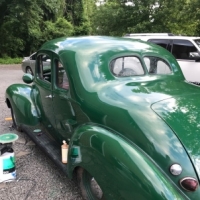heater wiring
Comments
-
ok park, here are some preliminary numbers. running the motor off my charger and no tach. i didn't check voltages and dont really feel like going back out right now. without the blade/cage assembly 2.2A @ 6V and 2.4A @ 12V. so the motor itself acted as i expected. with the fan reinstalled 9.5A @ 6V and 12.2 @ 12V. the question is, what is the effect of 50% increase in current on the motor's life?0
-
Interesting observations Nick! I went through my Aviation electrical manuals, and it would seem that Park is right in theory. There is no substitution for bench testing. This is a GREAT informative post!0
-
Nick, your post implies you didn't actually measure the voltage applied to the motor, just the currrent. A charger is not the ideal power source, as its output voltage varies quite a bit under different loads. For a definitive set of figures, you'd want to use a good meter and measure the motor input voltage as well as the amperage; and of course, measure both under the same conditions.0
-
Park W wrote:
Understood, I intend to do just that, last night's task was mainly to pull the unit. I happened to be separrating it next to the charger, so i opted to pull a couple samples just to get an idea where things were going it was late and cold and i realized i didn't check voltage while i was still out there. I plan to use a variable voltage source, track voltage, current and rpm's. The drag effects are considerable at the higher speeds and very well may be the limiting factor.Nick, your post implies you didn't actually measure the voltage applied to the motor, just the currrent. A charger is not the ideal power source, as its output voltage varies quite a bit under different loads. For a definitive set of figures, you'd want to use a good meter and measure the motor input voltage as well as the amperage; and of course, measure both under the same conditions.
i just hope i put the horsehair washer back below the fan before i reassemble, its been in the gloivebox for 17 years and it just doesn't control the vibration of the motor real well there. this experiment was a good excuse to finally tear it all apart and fix it.0 -
7XPacemaker wrote:
whatever the descrepency in theory/reality is, it is quite useful for testing as we can creep a machine around and chart the current draw with much higher resolution and at the sametime pinpoint anything going on within the machine to contribute to any spikes. (it also lets you crash in slow motion hopefully doing less damage.) not sure how useful this particular test will amount though.Interesting observations Nick! I went through my Aviation electrical manuals, and it would seem that Park is right in theory. There is no substitution for bench testing. This is a GREAT informative post!0 -
Nick, my comments are based on the assumption (maybe wrong!) that the windings of a small DC motor are essentially a resistive load, so the voltage-current relationship would be pretty linear. While not as strong as in a series-wound motor, these heater fan motors may still generate some internal "reverse voltage" when in operation, which would alter that assumed linear relationship. Will await your test numbers with interest. Park0
This discussion has been closed.
Categories
- 37K All Categories
- 106 Hudson 1916 - 1929
- 19 Upcoming Events
- 91 Essex Super 6
- 28.6K HUDSON
- 561 "How To" - Skills, mechanical and other wise
- 994 Street Rods
- 150 American Motors
- 174 The Flathead Forum
- 49 Manuals, etc,.
- 78 Hudson 8
- 44 FORUM - Instructions and Tips on using the forum
- 2.8K CLASSIFIEDS
- 602 Vehicles
- 2.1K Parts & Pieces
- 77 Literature & Memorabilia
- Hudson 1916 - 1929 Yahoo Groups Archived Photos

